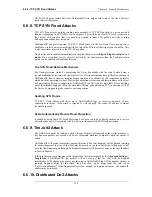
7.4. SAT
NetDefendOS can translate entire ranges of IP addresses and/or ports. Such translations are
transpositions, each address or port is mapped to a corresponding address or port in the new range,
rather than translating them all to the same address or port. In NetDefendOS this functionality is
known as Static Address Translation (SAT).
Note: Port forwarding
Some network equipment vendors use the term "port forwarding" when referring to
SAT. Both terms are referring to the same functionality.
SAT Requires Multiple IP Rules
Unlike NAT, SAT requires more than just a single IP rule to be defined. A SAT rule must first be
added to specify the address translation but NetDefendOS does not terminate the rule set lookup
upon finding a matching SAT rule. Instead, it continues to search for a matching Allow, NAT or
FwdFast rule. Only when it has found such a matching rule does NetDefendOS execute the original
SAT rule.
The SAT rule only defines the translation that is to take place. A second, associated rule, such as an
Allow rule, must exist to actually allow the traffic to pass through the firewall.
The Second Rule Must Trigger on the Untranslated Destination IP
An important principle to keep in mind when creating the IP rules for SAT is that the second rule,
for example an Allow rule, must trigger on the untranslated destination IP address. A common
mistake is to create a rule which triggers on the translated address given by the SAT rule.
For example, if a SAT rule translates the destination from 1.1.1.1 to 2.2.2.2 then the second
associated rule should allow traffic to pass to the destination 1.1.1.1 and not 2.2.2.2.
Only after the second rule triggers to allow the traffic, is the route lookup then done by
NetDefendOS on the translated address to work out which interface the packets should be sent from.
7.4.1. Translation of a Single IP Address (1:1)
The simplest form of SAT usage is translation of a single IP address. A very common scenario for
this is to enable external users to access a protected server in a DMZ that has a private address. This
scenario is also sometimes referred to as a Virtual IP or Virtual Server in some other manufacturer's
products.
The Role of the DMZ
At this point in the manual, it is relevant to discuss the concept and role of the network known as the
Demilitarized Zone (DMZ).
The DMZ's purpose is to have a network where the administrator can place those resources which
will be accessed by external, untrusted clients and typically this access takes place across the public
Internet. These servers will have the maximum exposure to external threats and therefore at most
risk of being compromised.
By isolating these servers in the DMZ, we are creating a distinct separation from the more sensitive
local, internal networks. This allows NetDefendOS to better control what traffic flows between the
DMZ and internal networks and to better isolate any security breaches that might occur in DMZ
servers.
7.4. SAT
Chapter 7. Address Translation
349
Summary of Contents for DFL-1600 - Security Appliance
Page 27: ...1 3 NetDefendOS State Engine Packet Flow Chapter 1 NetDefendOS Overview 27 ...
Page 79: ...2 7 3 Restore to Factory Defaults Chapter 2 Management and Maintenance 79 ...
Page 146: ...3 9 DNS Chapter 3 Fundamentals 146 ...
Page 227: ...4 7 5 Advanced Settings for Transparent Mode Chapter 4 Routing 227 ...
Page 241: ...5 4 IP Pools Chapter 5 DHCP Services 241 ...
Page 339: ...6 7 Blacklisting Hosts and Networks Chapter 6 Security Mechanisms 339 ...
Page 360: ...7 4 7 SAT and FwdFast Rules Chapter 7 Address Translation 360 ...
Page 382: ...8 3 Customizing HTML Pages Chapter 8 User Authentication 382 ...
Page 386: ... The TLS ALG 9 1 5 The TLS Alternative for VPN Chapter 9 VPN 386 ...
Page 439: ...Figure 9 3 PPTP Client Usage 9 5 4 PPTP L2TP Clients Chapter 9 VPN 439 ...
Page 450: ...9 7 6 Specific Symptoms Chapter 9 VPN 450 ...
Page 488: ...10 4 6 Setting Up SLB_SAT Rules Chapter 10 Traffic Management 488 ...
Page 503: ...11 6 HA Advanced Settings Chapter 11 High Availability 503 ...
Page 510: ...12 3 5 Limitations Chapter 12 ZoneDefense 510 ...
Page 533: ...13 9 Miscellaneous Settings Chapter 13 Advanced Settings 533 ...











































